 |
|
 |
2011
October
29-31
|
A radically new way to do college
[Revised October 30.]
I know I said I had closed out the month already, but I'm back. Here's what I've been thinking about.
I think two things about the American college experience are wasteful.
One is the fact that the summers aren't fully utilized.
The other is unclarity about what it means to be a full-time student.
I've written before about how a lot of University of Georgia students take more than four years to get
their bachelor's degrees. This is an artifact of a system that gives you the privileges of a full-time student even
if you are taking a 12-hour load instead of the expected 15 to 16. And once this starts, it becomes part
of the system — departments expect you to take a 12-hour load — and everybody gets slowed down.
I think we should admit that every undergraduate with less than a 15-hour course load is a part-time student.
What about people who need time to work their way through college? Fine — they can be 3/4-time students
and work 1/4-time. And they will need more than the normal number of years to finish their degrees.
There's nothing wrong with that. We might even extend this to graduate students on assistantships.
What we've got to get rid of is a set of clashing expectations: the degree requirements are designed for a 16-hour load,
some departments think a 12-hour load commits you to spending 100% of your time on your studies,
some students need time off to
work (which is laudable, but let's admit that it takes time), and some students expect lots of leisure.
The same goes for summers. After college, does anybody want a job where they'll be unemployed and unpaid for
three months out of the year? No? Then why run college that way?
I think the summer vacation echoes a time when college teaching was a hobby for the rich (which it was, before
1850 or so). It also reflects the era before air conditioning, when being indoors was often very uncomfortable.
Let's consider changing the semester system so there will be three 16-week semesters per year
(each 15 weeks of classes plus one week of exams, the same as now).
That totals 48 weeks; there are still four weeks to split between Christmas and inter-term vacations.
Then, if you went three semesters per year, you could do a bachelor's degree in three years.
You could still take summers off if you wanted — or falls, or springs.
Currently, not only do the summers leave buildings and other facilities under-utilized, there is also some
doublethink about professors' employment. Commonly, they are paid for nine months but are expected to do
substantial research during the three months for which they are not paid.
I have escaped this, one way or another, mostly by having started out as a 12-month employee.
But I'd rather see the doublethink go away.
Permanent link to this entry
Kudos
Kudos to Chase Visa for noticing suspicious charges on my Visa card, calling me, and then deftly
changing the account number (and issuing new cards) in a way that was transparent to Quicken;
all I had to do was change the account number in Quicken, and the new card picked up right where
the old one had left off.
Permanent link to this entry


|
2011
October
28
|
If everybody were "debt-free"...
[Revised October 30.]
A popular radio show coaches people in how to be "debt-free" and teaches them that they have a moral
duty to be so. And for some years, some preachers have been circulating the quite mistaken belief
that the Bible forbids us to borrow money.
What would the economy be like if everybody were really "debt-free" — if people rarely or never
borrowed money for any purpose?
Several things are obvious:
(1) There would be less business activity, and hence less opportunity for ordinary people to turn
their hard work into money.
(2) There would be less social-class mobility because only rich people
could go to college to train for high-paying professions. In 1920, only a rich man's son could be
a doctor. Do we want to move back into that world?
(3) The overall standard of living would be lower.
To own a house, you'd have to save up for 30 years.
Most people would never do this
and would live in small, rented properties.
Landlords, however, would be in hog heaven — the few people rich enough to own lots of
real estate would keep getting richer.
The main effect of abolishing consumer lending would be a world in which
the gap between rich and poor is permanent and gets wider.
Granted, there has been too much irresponsible borrowing in recent years.
Don't sign up for a house payment you can't afford just because you imagine you're going
to re-sell the house. Don't borrow $200k to go to a boutique college and major in nothing
in particular. But if $200k can make you an M.D. or $100k can make you a J.D. or an
engineer, and if the price of a good apartment, turned into a monthly house payment,
can get you a comfortable place to live that will appreciate in value, do it.
It's useful to know how to do without borrowing, in situations where
borrowing is common. You should always know what your alternatives are.
Perhaps the best thing achieved by the radio show to which I allude is that
people become aware of some alternatives.
And granted, the misuse of credit can impoverish people.
But my point is that the lack of credit can also impoverish people.
The opposite of falling off the horse on the left is falling off on the right.
But what we really want is to stay on the horse.
Permanent link to this entry
Like a fine Swiss watch, continued...
[Updated.]
A really important discovery I've made about my new-old Bulova watch,
trumping other discoveries, is this:
The self-winding mechanism doesn't wind it enough during the ordinary
course of my activities. I suppose I don't move around as much as the average
Bulova watch wearer of 1958.
So although it keeps running, its speed is more variable than it ought to be.
For a while, it was losing nearly half a minute a day.
The first symptom of inadequate winding seems to be that the movement of the
sweep-second hand becomes slightly irregular. It still covers a minute in a minute,
but it doesn't make all of the smooth 1/4-second steps. Some of them are replaced
by bigger steps at longer intervals. I have no idea why this happens.
I've taken to giving it a good shaking (in the appropriate direction, parallel to
its face) after taking it off each night. This seems to have restored it to the high
accuracy that it showed when I first got it back from the watchmaker, who, of course,
had wound it well.
Self-winding watches are an early example of energy harvesting — making
good use of energy that would otherwise be thrown away.
Another classic example is the heater in your car, which takes heat from
the engine that would otherwise be dissipated in the outside air.
(Which is why, when the engine overheats, you can cool it by turning
the heater on — a notion incomprehensible to people who think
a heater makes heat.)
Electronic applications of energy harvesting are coming. There is enough electromagnetic
energy in the air, in many places, that small CMOS electronic devices can feed on it.
I have some busy times coming up, so I'm going to close out the month now. Happy Halloween,
and, as always, remember it's HAL- (as in "Hallowed be thy name") not HOL-loween!
Permanent link to this entry


|
2011
October
27
|
I saw part of Halley's Comet yesterday
Of course, I saw all of Halley's Comet in 1986, when it made its last visit to the inner
Solar System. Regrettably, I didn't get good pictures of it. It swung rather to the south of us,
and I had to climb up on the hill behind my house to get a picture at all.
But early on the morning of October 26, less than 24 hours ago as I write this, I saw a cast-off
piece of Halley's Comet.
That is, I saw an Orionid meteor. I must thank Babbage, our dog, who wanted to be taken outdoors at
5 a.m. I was looking up at Orion, and at the lower right, from Lepus into Columba, a meteor briefly
streaked past.
Meteors from Halley's Comet always seem to come from Orion, and we encounter them every October 21-26,
roughly.
They are leftover particles from the comet which continue to orbit the sun at about the same distance
we do, so we run into them regularly.
The direction of the constellation Orion is roughly where Comet Halley spends its time.
To be precise, the comet spends most of its time in a direction close to the head of Hydra.
That's a bit east of Orion. Its orbit is a very long ellipse, so almost all the time, it is out
there, in more or less a fixed direction from the sun and from us.
I hope I live to be 104, and still have good eyesight, so I can see Halley's Comet again in 2061.
We'll get a better view then — it will swing north, into Auriga, and be much higher in the
North American sky.
Permanent link to this entry


|
2011
October
24-26
|
Watch for auroras
I didn't see the aurora borealis on the evening of the 24th, but plenty of people as far south
as the Atlanta area did. Here is what the satellite map of auroral activity looked like:

To see the current map, click here.
My rule of thumb: If the red part reaches the U.S. border, start looking for auroras in Georgia,
and if it reaches Pennsylvania, you will certainly see them.
Conditions can change appreciably from hour to hour. To learn more, see
spaceweather.com.
Permanent link to this entry
The synthetic-oil question
I've taken the plunge and have decided to convert all our cars to synthetic oil,
which is
a better lubricant than oil distilled directly from petroleum.
To be precise, I'm using
Castrol Syntec
and the oil changes are done locally at
Porterfield Tire, where
we've been satisfied customers for decades.
But I'm not going to prolong the oil-change interval. That, I think, is a red herring that
caused some early adopters of synthetic oil to have bad experiences. I'm still going to change the
oil every 3000 to 5000 miles or 6 months, whichever comes first (usually the 6 months).
Synthetic oil costs $25 extra per oil change. It may pay for itself in improved gas mileage;
I'm not sure. I get about 20 miles per gallon in town, so I use about 150 gallons of gasoline per
oil-change interval. If I can cut this to 144 gallons, the oil has paid for itself. That's a 4% improvement
in gas mileage (equivalent to going from 20.0 to 20.8 mpg). Will I get that much improvement?
I don't know (and I don't expect to be able to measure the difference; there's too much variation
in driving conditions from week to week). Even if I don't, I'll probably get longer engine life and better performance.
Permanent link to this entry


|
2011
October
21-23
|
Milestone reached
I want to thank the Winder-Barrow High School Class of 1976
for putting on a good 35th-year reunion dinner last night (Oct. 22) —
and for letting me marry their valedictorian, back in 1982.
I went around introducing myself as the man who married Melody Mauldin.
I'm proud to have attained this honor!
Permanent link to this entry
A note about graduate school
Every year, a few students arrive who, when asked what particularly
interests them, will say, "I have an open mind —
I'm here to learn whatever you'll teach me."
That is not as good a sign as you might think.
For a master's or doctoral degree, the student has to carry out a project
of his or her own design. That means incoming students
should be the kind of people who want to do something, not just
sit and absorb.
They should already be the kind of people who pursue projects.
We will help them find better projects.
Sometimes, "I have a completely open mind" may mean
"I don't know what this subject is, but they tell me I can make money if I study it."
And that's a rather bad sign.
Speaking of employment, though, congratulations to my student, Dr. Cody Boisclair, who has landed
a job in Boston with a handsome salary, just two months after (summer semester) graduation.
He had a very definite project in mind — making computers measure the complexity
of English sentences — and carried it out well.
I have revised several of the earlier entries this month (below).
Permanent link to this entry


|
2011
October
19-20
|
Secret information displays on the 2012 Ford Escape
(Also 2004 Taurus and many other recent Fords)
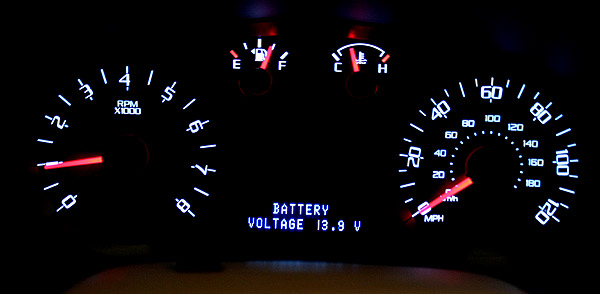
In what follows I'm indebted to this posting
for putting me on the trail of something interesting.
I assume you already know about the INFO button, and you know that the SETUP button will give
you more information, such as an estimate of how soon you'll need an oil change.
Those things are documented in the owner's manual.
But there's more. Try this:
(1) With the engine running, press INFO and get to one of the displays where pressing RESET
won't lose any information you care about. The odometer, the blank display, or the instantaneous
MPG display are good choices.
(2) Shut off the engine. Then start the engine, holding down RESET the whole time. Keep holding
down RESET until the words ENGINEERING TEST MODE appear.
(3) Using RESET, you can cycle through a large number of additional displays. One of them sweeps
all the gauges through their range (to make sure their pointers can move freely). Another illuminates
all the pixels in the text display. But those are boring ones...
You can also check ROM versions, odometer rollover count (presumably for those of us who drive millions of miles),
read the tachometer and speedometer digitally, and display various temperatures and the battery voltage.
Of these, the battery voltage display may be the most useful.
But I don't know if you can display it without running the engine, so it's really only a test
of the charging system.
It works very much the same way on our 2004 Taurus. I'm told that on appreciably earlier Fords,
there is a similar mode but with a more cut-down display, such as tESt
(on seven-segment displays) for Engineering
Test Mode and bAt for battery voltage.
Permanent link to this entry


|
2011
October
18
|
What research is like
Some people imagine that researchers occasionally make "breakthroughs," and
when they're not doing that, they're wasting time and money.
That is like imagining that farming takes place only on the day of harvest.
Permanent link to this entry
Short notes
R.I.P. Dennis Ritchie: The co-inventor of the UNIX operating system
and the C programming language has died. He had as much effect on computer
programming as Steve Jobs did on computer usage.
For example, UNIX introduced the idea of storing files in folders each of which
can contain more folders, to any depth. Previously, you had one layer of folders
(called partitions, or volumes, or something) each with files in it.
Arguably, Ritchie gave us the '/' or '\' in file paths.
[Updated twice.] Like a fine Swiss watch:
My half-century-old Bulova 23
(which is a fine Swiss watch) is back from a trip
to the watchmaker for maintenance and adjustment.
For the first few days, it was extremely accurate, gaining 2 seconds during the
course of the day and losing 2 seconds overnight.
Its behavior overnight depended on the position it was left in.
As the lubricants continue to distribute themselves, it has settled into a routine
of losing about 15 seconds a day, which is acceptable.
I'm going to see what further changes ensue.
Yesterday's photography: In yesterday's automotive illustrations,
I was experimenting with a ring light
not as the main source of illumination, but as fill flash.
It worked well. Ring light by itself might have been too flat.
Hancock County (Georgia) football brawl:
Newspaper accounts seem to be undergoing hour-by-hour revision, but it appears that
a football game there turned into a brawl between the teams
and put the Warren County coach in the
hospital for reconstructive face surgery. Ouch! Can we suspend both schools
from playing football
for five years, please? And make them change their colors and mascots when they come back?
Not to mention criminal prosecutions and civil liability for the guilty.
Permanent link to this entry
Bad automotive puns
(To Sharon, entering a parking lot
on a rainy day:) "Not only are we driving a Ford, we're fording a drive."
"Some say chivalry is dead, but I say no, the ones that got discontinued were Oldsmobile and Pontiac."
Permanent link to this entry


|
2011
October
16-17
|
Replacing the cabin air filter in a 2004 Ford Taurus
(Probably also 2000, 2001, 2002, 2003, 2005, 2006, 2007)
Since it's Car Care Month here in the Daily Notebook, let me document one more procedure.
In what follows, I'm greatly indebted to
"93sable"
on taurusclub.com for instructions, but our car
turned out to be a little different from his, and anyhow,
I wanted to experiment with a photographic technique
(ring flash illumination followed by unsharp masking),
so here goes.
This procedure is much simpler than described in some service manuals.
Open the hood and remove the three clips that hold the cowl on the passenger side.
Note that two of them also hold windshield washer lines.

Lift up on the cowl. Pull up gently to release some hidden pop-fasteners, and you can raise the cowl and another
plastic cover that is under it, revealing where the filter goes:
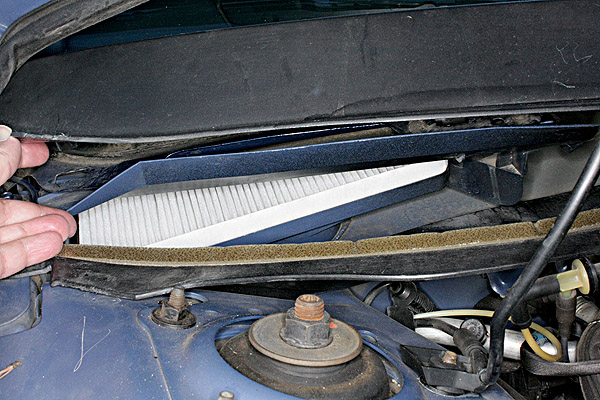
Here you see the new filter in place; the old filter was much darker.
Some Fords may not have the old filter at all. Before putting the new filter in,
I vacuumed out dust and leaves, followed by a further dusting with a wet rag, and then
sprayed Lysol into the intake with the air conditioner fan
running, and immediately turned the fan off so the Lysol could dry in place
and kill microorganisms. Next step will be to run the air conditioner for
a while and air everything out.
That's it! Snap everything back together, reinstall the clips, and you're done. Maybe ten minutes' work.
Permanent link to this entry


|
| |
|
2011
October
14-15
|
Re-engineering the trunk light of a 2004 Ford Taurus
(Probably also 2000, 2001, 2002, 2003, 2005, 2006, 2007)
The original trunk light in our 2004 Ford Taurus didn't meet our needs.
It's small and located off to one side, so that a single grocery bag can block
all the light from it, and even if unblocked, it shines more in your eyes
than onto the cargo:
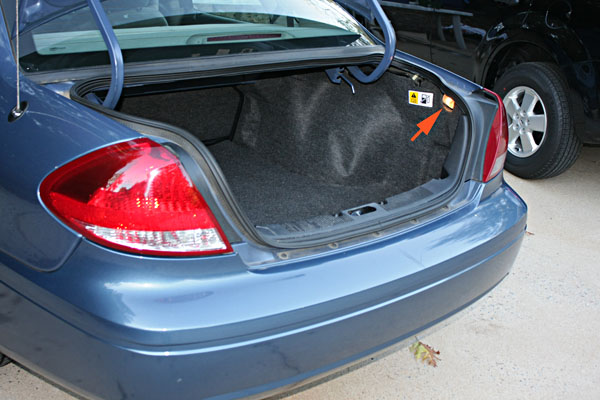
What follows is the story of how I re-engineered it. It may inspire some of you to
do something similar.
The first step was to build the light fixture. The only real requirements are that it should
mount with a single 8-mm hole and that neither side of the light bulb can be grounded to the car's
frame. I used a replacement dome light mounted with plastic screws
onto a scrap of 1/4-inch acrylic (cheap or free at
a glass store, especially since scratches and blemishes are OK).
Metal screws wouldn't do because grounding must be avoided.
Any light that draws up to 2 amps or more is all right.
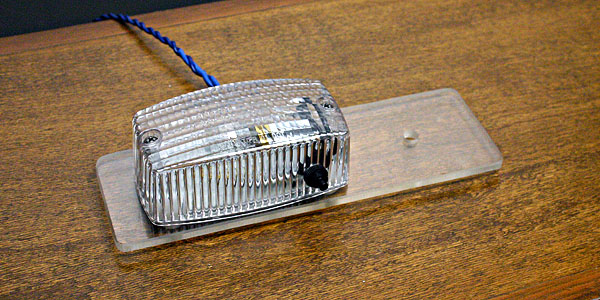
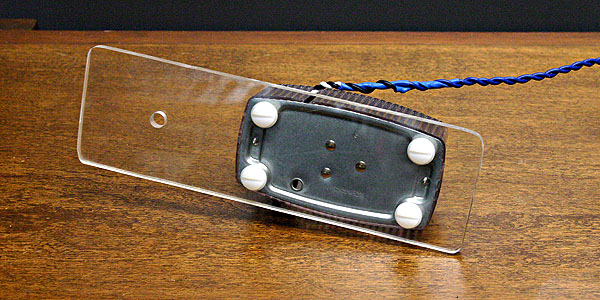
There's a mysterious 8×1.25-mm-threaded post coming out of the deck above the trunk,
just astern of the radio speakers, and that's where I mounted the light fixture.
Here you see the area before installation:
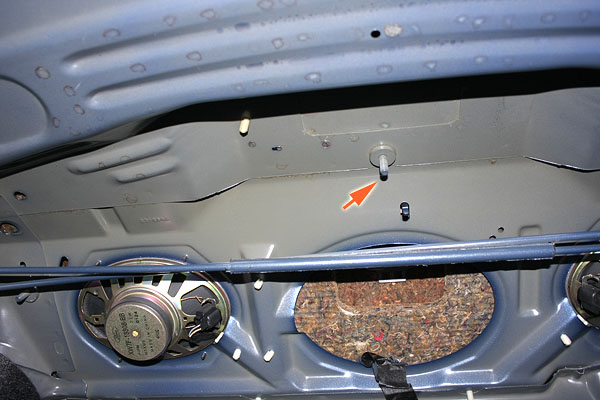
Here you see the light fixture held in place with a single 8-mm wing nut and washer.
Important: The wires must be kept well away from the torsion bar that raises
the trunk lid, so they're secured to a pair of holes using a wire tie. This is easier
than it looks because you can reach the holes from above, through the unused center
speaker opening. (Who has wanted to put a single speaker in the center since about 1970? But Ford
still leaves an opening for it.) It helps if you bend the wire tie into a sharp curve
before inserting it.
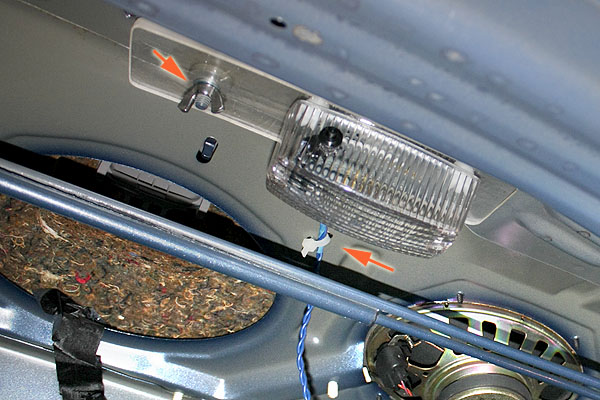
Next step was to add two stick-on wire clips to route the wire horizontally behind the rear seat.
It will go under the lining at the position of the third arrow.
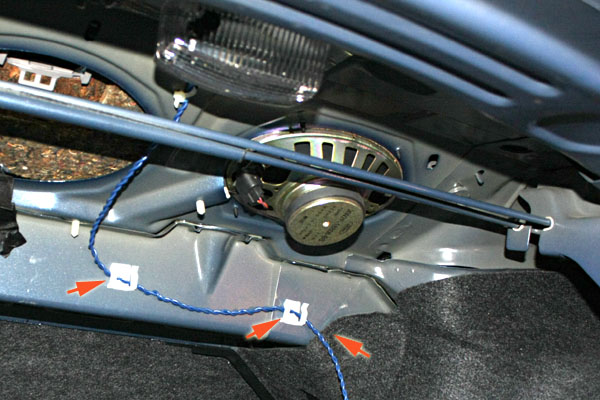
Next, I pulled back the lining to expose the existing trunk light, unplugged the connector from it,
and used tap connectors to
connect the new light fixture to the existing wires. I chose to leave the original trunk light disconnected
and put a piece of tape across the end of the connector.
(Note: With this type of connector, it's OK to work with the circuit energized because there
is very little risk of a short. Complete one tap connector before starting the other, of course.)
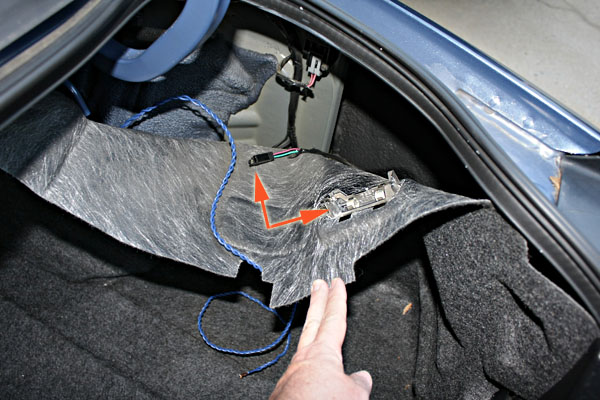
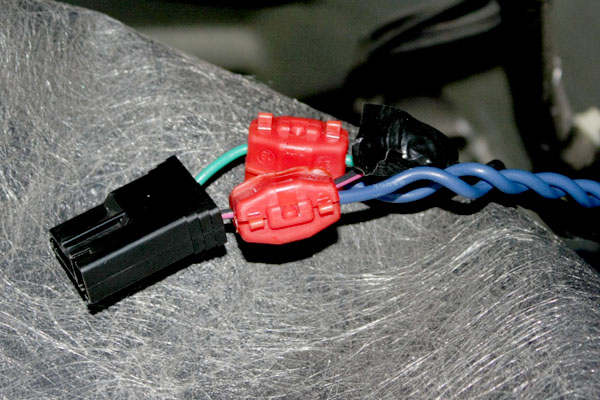
Finally: It works! The striped pattern from the cheap dome light is amusing but causes no problems.
And the light can't shine in our eyes unless we practically climb into the trunk. Success.
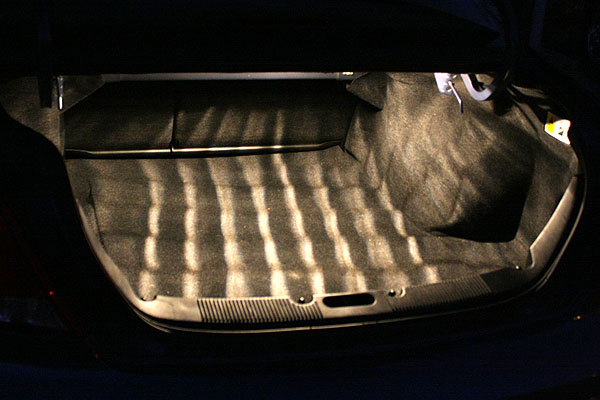
Permanent link to this entry


|
2011
October
12-13
|
Driving a car 50 years ago
Since automobiles seem to be this month's theme, I thought some of our younger
readers might want to know what it was like to drive a car half a century ago.
I didn't actually do so myself — in 1961, I was not even in kindergarten yet —
but I learned to drive in a 1969 Buick and briefly drove some older cars in the 1970s.
Getting into a 1961 car, you'd notice, with a sigh of relief, that the controls are
mostly familiar. The controls of passenger cars were standardized in the early 1950s.
You even have an automatic transmission, although it may have only two forward gears.
The gearshift and the turn signal levers come out of the steering column, just like today,
but they have no other functions; the lights and windshield wipers are controlled from
the dashboard. The ignition switch is on the dashboard too.
The headlight dimmer is a foot switch that you work with your left foot.
There is, of course, no seat belt. Lap belts were uncommon until about 1965, and not
commonly used until about 1975 (except for one devilish model year, maybe 1972,
when regulations required an interlock switch to keep you from starting the engine if
your seat belt wasn't fastened). Shoulder straps came even later.
Starting the engine is done the same way as today, mostly. Turn the switch to "start"
and wait for the engine to catch, then let the switch drop back to "run."
If you're lucky, the engine will keep running.
But if the engine is cold, you need to set the automatic choke. Press the pedal to the
floor and release it before starting. Then start the engine, and it will idle faster
until it warms up.
Some people couldn't keep their foot off the accelerator during the starting process.
They often flooded the carburetor and had trouble starting the engine. But let's assume
you're not in that fix. You've gotten it running.
Shift into R or D and pull out. Again, if you're lucky, the engine won't stall.
Cold engines are finicky when they don't have microprocessors keeping them constantly
adjusted. But the engine usually won't run as smoothly as a modern one, even when
it warms up. In those days "tune-up" meant more than scheduled maintenance —
it meant trying to "tune" the engine to run well.
And in those days, people rarely had to change lanes.
There's no outside mirror on the right.
There may not even be one on the left.
A word about steering. I assume you're in a mid-size American car. By mid-size
I mean, of course, enormous, at least in footprint, if not in cargo capacity.
Today's full-size cars (Taurus, Camry) are the size of 1960s "compacts" (Valiant, Dart).
The typical American car of those days didn't have rack-and-pinion steering.
As a result, the steering would usually feel loose — you could turn the
steering wheel an inch or two in either direction before anything happened.
A modern driver, experiencing this for the first time, might feel that the wheel
was about to come off in his hands. But no — it's supposed to be like that.
It gives big American cars their classic boat-like handling.
Then there are the tires. When radial tires came in, around 1975, we all felt they
were curiously characterless — they went exactly where we steered
them, without expressing any opinions of their own. Not so the bias-belted tires
of the Sixties. They had opinions. If in good condition, they preferred to travel
in straight lines. If properly aligned, they preferred to travel the way the car was
already going. If not, you had to give extra attention to steering, which might require
actual muscular strength if you didn't have power steering. Some people felt that
steering was more fun when you had an opponent.
Correcting for inflation, American family cars cost about the same as they did fifty
years ago, but modern ones have vastly higher performance in all respects except
engine power. Back in the Sixties, people felt that
having a powerful engine was important. They remembered earlier cars that had
trouble climbing hills or maintaining freeway speeds. Besides, big engines are
something Detroit was good at. Reliability wasn't. It was normal to trade a car
after two years; a five-year-old car was considered old, many people considered a car
worn out at 25,000 miles, and a car that survived
to 100,000 got media attention.
Permanent link to this entry
Quicken versus SunTrust
I bank at SunTrust and, being something of a financial nerd, download my transactions
on all accounts into Quicken every day. For three or four credit cards and Paypal, this almost always goes
smoothly. For SunTrust (where I have four accounts to download), it usually works,
but several times this month, I've had it stop working (or, in two cases,
stop downloading while reporting
a successful download).
I'm using Quicken's "Express Web Connect," which means they're web-scraping SunTrust's web site.
The failures are caused by SunTrust making minor changes in their web site, as best I can determine.
When the process ceases to work, here is how I restore it to life:
(1) In Tools, Account List, click "Edit" on every SunTrust account and disable the download (update) feature.
(2) Tell Quicken I want to add a new account, which is a credit card at SunTrust. It must be a credit card.
Stick with me here...
(3) Let Quicken connect to SunTrust and find my accounts. It will tell me I have to change my SunTrust password,
but that is false and doesn't work if attempted. Instead, I type the same password for the old and new ones.
Quicken chides me but lets the connection proceed.
(4) When prompted, link each of the new-found accounts to the appropriate pre-existing one. That is, even though
I said I was going to create a new account, I end up not doing so.
(5) Let the download proceed, then check for duplicate transactions (unlikely unless the error condition had
persisted for some days).
That's "Express Web Connect." Quick also supports "Direct Connect" but it has to be enabled by the bank.
So today I went and asked them to enable it. They replied, "You have to subscribe to PC Banking for $10 a month."
For something that's less work for their computers than the way I'm doing it now? No, thanks!
Permanent link to this entry
Miscellany
What's wrong with the economy: Policy uncertainty.
People aren't going to make plans if they don't know what the government is going to do next.
And they're not going to make long-term plans in response to a temporary "stimulus."
Google Ads are back. I am again putting Google Ads in this blog, now that they are doing a much
better job of recruiting prestigious advertisers, or at least staying on topic. If they get weird on me,
they'll go away again.
Permanent link to this entry


|
2011
October
10-11
|
The Ford splice
Browsing through Ford automotive manuals, I see that they recommend a technique
for splicing wires end-to-end that is quite different from the usual "butt splice"
or "Western Union" splice — it is much easier to make,
the area that needs insulating is smaller, and you usually do not
need any separate support for the wires while soldering.
This is only for stranded wire. I think it would cause solid wire to break.
First, twist the wires together like this (not end to end):
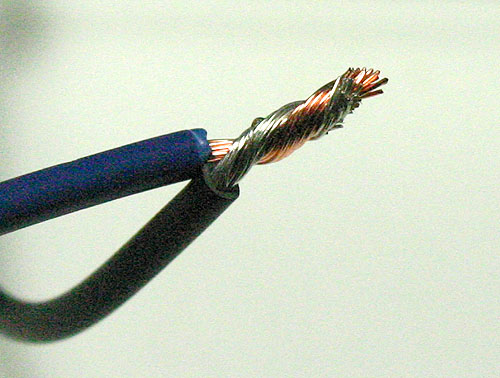
Next, solder, and then bend one of the wires 180 degrees, like this:
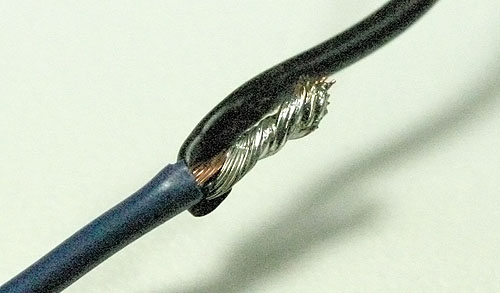
Crimp it if necessary with pliers, and then add heat-shrink tubing for
insulation, heat it, and shrink it:
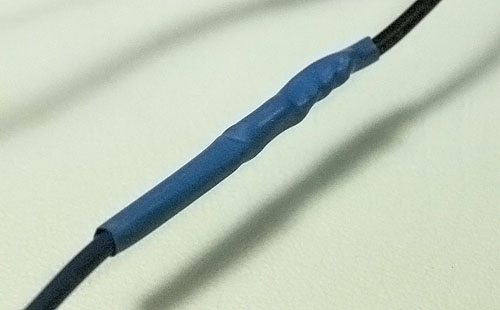
There! Quick, simple, and reliable.
Permanent link to this entry


|
| |
|
2011
October
8-9
|
Adding a cabin air filter to a 2012 Ford Escape
(Probably also 2008, 2009, 2010, 2011)
The cabin air filter in a Ford is a "dealer-installed option," which means it isn't
installed at the factory. Some people feel they get better performance from the air
conditioner without it. There wasn't one installed in my 2012 Escape, so I added one.
The procedure is much simpler than described in some instructions you will find.
You don't have to remove the wiper arms or the cowl. The only tool needed is a
#2 Philips screwdriver.
STEP 1: Open the hood and look at the cowl on the passenger side.
Remove the three fasteners indicated.
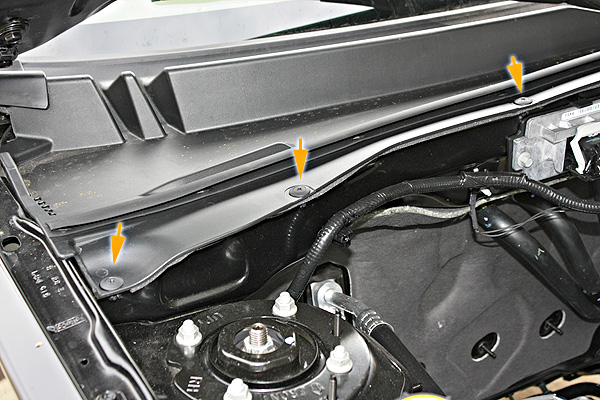
The fasteners may puzzle you — they look like screws but don't work like screws.
They are push fasteners. The screw-like part simply pushes in to expand the other part:
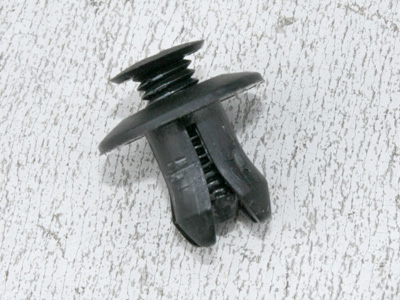
To get the fastener out, squeeze the lower part (under the cowl). This will engage the
threads so that the screw-like part can be removed with a screwdriver.
STEP 2: Lift the cowl. This will reveal the air intake box.
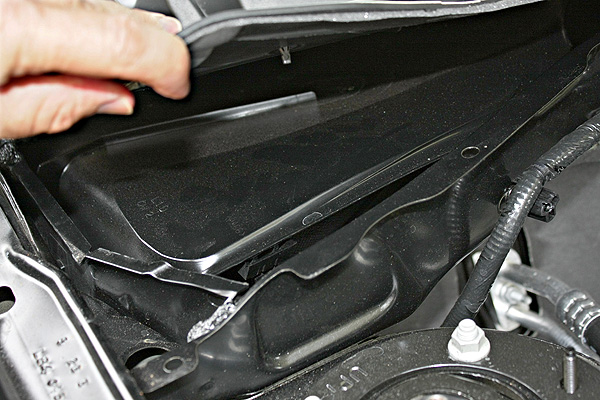
STEP 3: Open the air intake box. This reveals where the filter will go.

STEP 4: Insert the filter. Note that it does not fit the foam-lined opening you saw
in Step 3 — at least mine (Purolator) didn't. It fits snugly somewhat higher up,
about three inches from the top, well below the mesh in the front of the box
(which is where air is taken in).
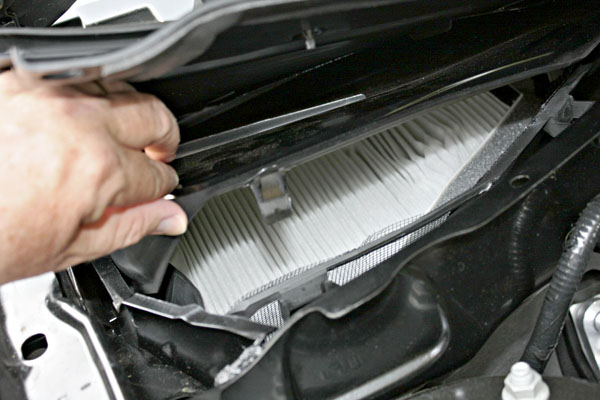
Since everything I do leaves a trail of documentation, my last step was to add a label,
to clue in any future mechanics that the car has a cabin air filter and that it's easy
to get to:
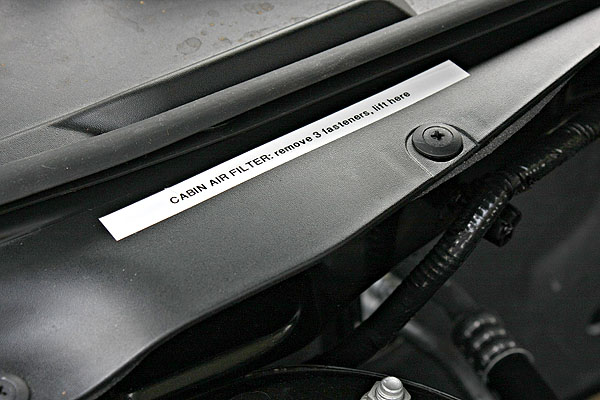
If you install a cabin air filter for the first time on a car that has run for a while
without one, you may need to do some cleaning first. I installed mine when the car had
only 400 miles on it and everything was pristine.
Permanent link to this entry
Photoshop techniques for auto repair illustrations
Why do the pictures above look so much better than what you often see?
Let me share a few tricks of the trade.
Although I used Photoshop CS5.1, much cheaper software will do everything you actually
need. All you have to do is find the equivalent of the Photoshop "Levels" menu.
Of course, the camera must work properly and focus at the desired distance. If you're photographing
something small (such as a single screw or other small part), you need macro mode, usually
signified by a picture of a flower on the camera's controls. I didn't need it for the picture I'm
about to show you. The other thing to control is light, and whether the flash is on.
In the example, my camera's flash was turned on, but you will often get better results without
flash if there is plenty of light from other sources. And if working in dim light, you must
hold the camera steady with a tripod or clamp of some kind (a problem I didn't have in this case).
Now then. Here's a picture as it came out of the camera (but resized for a web page):

Like many digital camera pictures, this one needs its midtones lightened.
In Photoshop, hit Ctrl-L for Levels. (In anything else, there is an adjustment like this one;
it might be called "histogram;" look for it.) Then move the middle slider to the left.
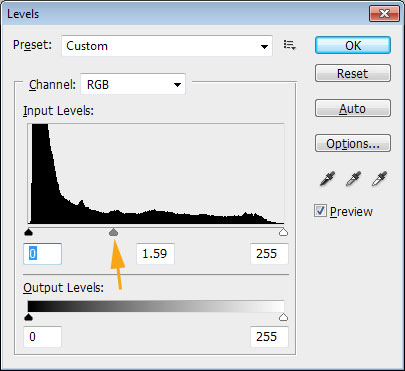
Presto! Here's the result. Look at how much more you can see:
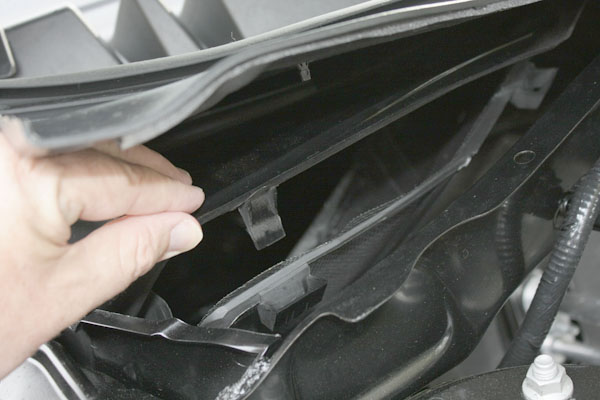
The next step is optional and a bit advanced.
My hand was close to the flash and came out unnaturally light.
Using the Lasso tool (for selecting irregularly-shaped
areas of the picture), and telling it to feather the edges about 20 pixels, I selected
the hand and darkened it by doing the same Levels trick again, but this time just
to the hand, and moving the middle slider to the right:
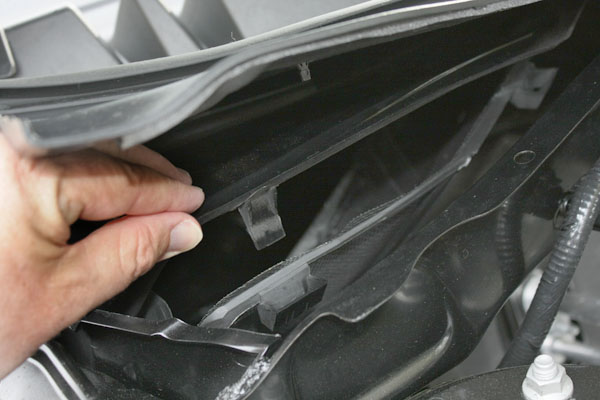
The last step is to use Sharpen and Unsharp Mask features (especially the latter) to
bring out detail. Here's the result:
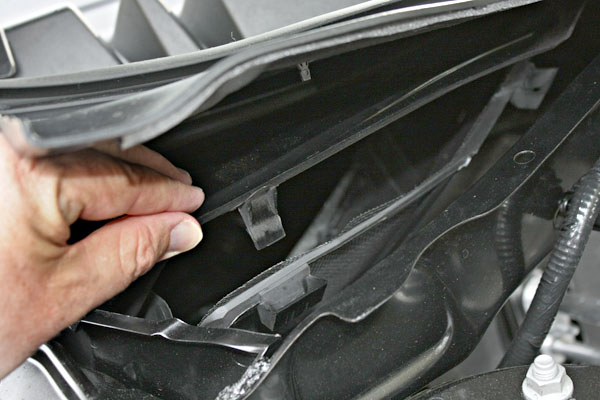
Not bad, is it? And easily within reach of low-end cameras.
I was using a Canon DSLR, but a pocket camera would do equally well.
To give you a better idea what Unsharp Mask does, here's the result of using way too much of it:

Not ideal, but even this has value as an illustration.
Some of the best automotive illustrations have always been unsharp masked,
even when that had to be done photographically by (literally) stacking an unsharp mask
(a blurred positive) with a negative, then duplicating to raise contrast. Now it's easy
to do the same thing digitally.
Permanent link to this entry


|
2011
October
7
|
|
Steve Jobs, 1955-2011
A computer pioneer who was just two years older than me has died.
Mortality has reached my own generation — the computer pioneers
of the 1970s and 1980s, the successful young geniuses.
Steve Jobs didn't invent personal computing. Single-user industrial computers
had existed since the 1960s. Nor was the Apple II the only personal computer
of its time — the Commodore PET and original Tandy TRS-80 came to market
the same year, and indeed, the Wang PCS-2200 slightly preceded it.
Nor did Henry Ford invent the automobile. But I think Jobs and Wozniak's
Apple II closely parallels the Ford Model T in its impact on the world.
It was easy to buy as a self-contained unit, ready to use, complete, with
lots of accessories and support and, most importantly, a large and fast-growing
user community. In the same way, the Model T was the first car most people could
afford, and it was delivered ready-to-use, with detailed instructions and
no assumption that there would be a mechanic nearby.
The Apple II and the Model T defined the personal computer and the automobile,
respectively, in a way that permanently changed our culture.
(Yes, the first Apple you saw was the Apple II. Its predecessor,
the plain Apple, was sold only as a kit and is very rare.)
I use some Apple products but am not really an Apple devotee; I don't have the
emotional loyalty that many Apple users do. Apple computers are well built,
but they are not magical; other companies also produce good products.
Still, nobody can fail to appreciate what Jobs and Wozniak did for
personal computing and personal electronics. Now one of them is gone.
He will be missed.
Permanent link to this entry
|
Two image processing notes
Photoshop hint: If you mainly produce images to be seen on the Web,
go to View, Proofing options, and choose sRGB or Windows RGB.
The default, Working CMYK, is for images to be printed on paper.
MaxIm DL hint: Those who cannot remember the past are doomed to repeat it.
Back in August I was again bitten by this.
Symptom: Calibration didn't remove the noise it was supposed to.
Permanent link to this entry
Notes about how to run the world, or parts of it
What are we to make of "Occupy Wall Street"?
Hard to say. It seems to be a mixed protest of people who dislike the current state
of affairs for a wide variety of reasons, from hardline Marxists to people who might
fairly be called conservatives. The most defensible part of this vague, odd-shaped protest
is concern that a few of the extremely rich have received protection from the government
at the expense of everyone else from the poor up to mere millionaires. The bank bailout
is part of it. Other policy issues, such as tax loopholes, are also involved.
Should people be let off their loans?
We are now seeing concrete proposals from the Left (such as
this)
to stimulate the economy by cancelling debts.
My concern? This could be massively unfair by rewarding people who borrowed unreasonably,
rather than those who managed their money well. If we're going to give out money, let's tie it
to productive rather than wasteful behavior.
I may have given the University a catch phrase: "Honors without borders."
What I mean is that the edges of the Honors Program should be fuzzy; instead of declaring
a couple of thousand students to be "in" and the rest "out," the Honors Program should provide
opportunities to talented students in a flexible way, in relation to their needs and abilities.
(There is indeed a policy shift going on in this direction.)
We do want to provide special incentives to students with special talent.
But I'm uneasy with being a two-tier university, now that all of our students are performing
on the level of the honors students of 1975.
Things I've caught myself saying lately:
(1) "I have a diverse group of friends. I collect odd ideas -- just not in my own head."
(2) "I respect hard work, especially when I'm the one doing it."
Permanent link to this entry
Why I don't like being pirated
The other day someone told me about a web site in Italy that was giving away e-book copies of
my DSLR astrophotography book, as well as other amateur astronomy books, free to anybody who
wanted them.
That is of course against copyright law. More to the point, it can do real harm.
I am grateful for amateur astronomers who have chosen to give their work away free (such as
Registax software). But I've chosen to go the commercial route with my books so that they will
be widely available and will remain so for a long time.
I don't get rich writing these books. Some people imagine every book author makes millions.
No; most scientific books barely turn a profit.
And the real issue is not my royalties, it's the publisher's investment.
Cambridge University Press spends tens of thousands of dollars on editing, typesetting, design,
and production of each book. They have to be able to earn this back by selling the books
(on paper or as e-books).
If they don't expect sufficient sales, they won't publish the book.
And if a pirate comes along and cuts deeply into the sales after a book is published,
causing it to lose money when it could have been profitable,
the publisher won't publish the next book.
So the people who give away my books free on the Web are trying their best to end my career
as an astronomy book author — whether or not they thought of it that way.
Permanent link to this entry


|
2011
October
6
|
Automobiles I have known and
loved, hated, or puzzled over
Having just bought a new vehicle, I find myself inclined to look back at other cars I've known.
I must make it clear that I don't fall in love with cars, the way some other people do.
For me, a car is an expendable tool. (Cameras, maybe. I was extremely fond of my Olympus OM-1 but
was temporarily lured away from it by a glamorous Nikon F3HP... Not, however, cars.)
So here goes. I'm going to describe the family cars as I was growing up, then the cars Melody and I
have owned. I will have very few hyperlinks. You can look these cars up on the Web yourself.
Family cars:
Some kind of Mercury that I don't remember. I think my parents brought me home from the hospital
in the predecessor of the Olds that I'm going to describe next. I have no memory of it.
1958 Oldsmobile 88 (?). This is the first family car I remember. It was grayish or silver,
with neutral-colored interior. I remember four headlights and the word OLDSMOBILE across
the front, so it must have been a 1958. Yes, I remember this from when I was less than four years old.
1961 Chrysler Newport, 4-door, white with red interior. This is the first car that caught my attention,
and I've written about it before. It was our first car with air conditioning. It had an alternator
(which I remember clearly) and a pushbutton-controlled automatic transmission. And it looked more
like a rocket than a car ordinarily does.
More about it here.
1965 Buick Electra 225, 4-door, beige with beige interior. This car (from Southwell Motors in Valdosta)
was a demonstrator and had every optional factory-installed gadget except the spotlight. It had cruise control,
an automatic headlight dimmer, an AM radio with a "search" function (which in those days was achieved
with a motor turning the tuning capacitor!), and a rear deck speaker. (No FM and no stereo in those
days.) Also a trunk release knob hidden in the glove box. And fender skirts.
1969 Buick Electra 225, 4-door, yellow, pale neutral interior (as I recall). By the time my mother
bought this one, my father was no longer with us. She stuck with the same kind of car, with slightly
fewer gadgets. I seem to recall this one had FM radio but no tape player. It is the first car I drove.
It handled rather like a boat.
1973 Buick Electra 225, 4-door, again yellow, with a white vinyl top and a light neutral-colored interior
and boat-like handling.
This enormous car lasted a long time,
by 1970s standards — I think my mother kept it as her backup car until about 1980.
It was the first car with a tape player and full-fledged stereo system.
After that, my mother had two Cadillacs, one of which will reappear later in this story.
My cars, in student days:
1973 Plymouth Valiant, 4-door, yellowish metallic green (a rare color) with green interior.
This was bought for me so I could drive to school. It looked exactly like the green car
depicted here.
That page's author describes it as "relentlessly mediocre," which is a fair description.
It was an unpretentious car, designed to be serviceable but not impressive.
The other thing it proves is that even 1973 pollution controls could not stop a Slant 6.
The engine was very reliable, but the pollution controls made it un-tuneable —
any setting of the carburetor that didn't produce dieseling would produce a rough idle.
This was, also, the last car I'll mention that had bias-belted (non-radial) tires.
The radio was AM only, which meant that I heard a lot of curious oldies on WGAU while
driving around Athens.
1976 Buick Century, 2-door, very bright green with white vinyl top and white interior.
My mother insisted on trading the Valiant for this in 1976; she thought I needed something
more glamorous. Because it was such a performance improvement, I couldn't turn it down,
but I never really bonded with it.
While I was in graduate school and didn't need a car,
my mother took it back (with my consent) and traded it on a Cadillac.
Melody's and my cars:
1976 Toyota Corolla, station wagon, brown with tan interior, with 2T-C engine.
This car was Melody's dowry, a gift from her parents. We drove it to Los Angeles in 1982
and drove it back to Georgia in 1984. It then became my daily drive-to-work car, and we
kept it until 1996, by which time it had been repainted cream-colored.
1976 (?) Cadillac Calais, 4-door, black with red interior. Melody's father helped
us find this, and we became a two-car family shortly after moving to Athens.
We had this car only about one year (in 1984-85). It was Melody's "maternity car,"
easy for her to drive, with plenty of room, while we were waiting for Cathy to be born.
It's the car in which Cathy came home.
(Yes, Cadillac Calais, an uncommon nameplate.
I know there's such a thing as an Oldsmobile Calais, that
that's not what this was.)
1982 Cadillac V8-6-4 Sedan de Ville, 2-door, silver blue with dark blue leather interior.
This is the car we inherited from my mother when she died in 1985. We only kept it a few months
because, although luxurious,
it was very mechanically unreliable. We started joking about the $600 cover charge at
the Olds dealer. I don't blame the dealer; it was very hard to service this type of engine
back in 1985.
This was the first microprocessor-controlled engine we encountered, and it was far ahead of
its time. It ran on 4, 6, or 8 cylinders as it felt the need, so it was rather like driving
with two automatic transmissions, one of them inside the engine.
It had a dashboard display of miles per gallon and other things, as modern cars do.
It relied on an oxygen sensor, fuel injectors, a catalytic converter, and other parts that
were very unfamiliar in 1985 but are on every car now. This web site
opines that the 1982 version of this engine was much worse than the initial 1981 version.
We traded it after it died on the road, with a clogged catalytic converter, presumably caused
by an electronic control malfunction.
1985 Plymouth Voyager minivan, metallic gray with gray interior.
We paid a premium to get a minivan; they were very much in demand at the time,
and this one served us well for ten years. It was ideal for transporting the children
on long trips.
1995 Dodge Caravan minivan, white with gray interior.
This was intended as an exact replacement for the previous one; we made the trade in
Valdosta during a family trip, when the first minivan underwent an expensive air
conditioning failure.
The usefulness of a minivan is hard to beat, but the reliability of this one disappointed us
a little. It had to have a new transmission at about 60,000 miles and was due for another one,
at about 120,000, when we decided to junk it (just a year and a half ago).
And it ended up not being junked; instead, a mechanic bought it and is going to put a
secondhand transmission in it.
During all of this time I continued to use the 1976 Toyota to drive to work, until...
1995 Oldsmobile Cutlass Ciera, 4-door, white with dark red interior
(colors that remind me of the 1961 Newport),
bought as a 1-year-old ex-rental. This car was a living anachronism;
it was basically an 80%-size model of a circa 1980 full-size car, and it very much reminded
me of my mother's first Cadillac. It was comfortable and I enjoyed driving it, but
it had remarkably little cargo space. It was also a "know-it-all car" — the lights
and locks were entirely automatic, and I had to have the electrical system modified to be
able to use the car on astronomy trips.
The Olds is what I drove to work until last week; then we traded it (still alive and
vigorous at 108,000 miles) for a 2012 Ford Escape recently mentioned.
But there's more. When we gave up on the minivan, Melody drove Sharon's Volvo for a while
(Sharon being away at college and not needing it), and then we bought a
2004 Ford Taurus, 4-door, blue, which is Melody's daily driving car and was the
family road-trip car until we got the Ford Escape.
There. That's the roster, omitting Cathy's and Sharon's cars. You might detect a shift
toward Ford, and that's right; we were impressed by the engineering and construction quality
of Cathy's 1997 Taurus, and that led to more Fords.
Permanent link to this entry


|
2011
October
5
|
Happy birthday, Melody!


|
2011
October
2-4
|
Not arthritis, just bad shoes!
Today on Medical Mysteries: How I cured my sore knees.
Notice I don't say "diagnosed." I'm not sure exactly what part of my knees was sore
or exactly what mechanism was involved.
What I know is that, for about two months, my knees had been acting up, especially when
I climbed stairs or walked on uneven terrain.
I thought old age was taking its toll. It kept getting worse and I tried wearing a knee
brace, which helped. I started wondering how soon to go to the doctor.
Well... It came to my attention that I was having good days and bad days, alternating.
Eventually it came to my further attention that the bad days happened when I wore a
particularly old pair of SAS walking shoes. The shoes were comfortable but badly worn
on the soles. They were able to rock from side to side in a way that shoes don't
normally do.
For a day I switched to running shoes, and my knees were much better. After
about three days without the bad shoes, they're practically cured.
Staircases of the world, I'm no longer afraid of you!
Permanent link to this entry


|
2011
October
1
|
The truth about video astronomy

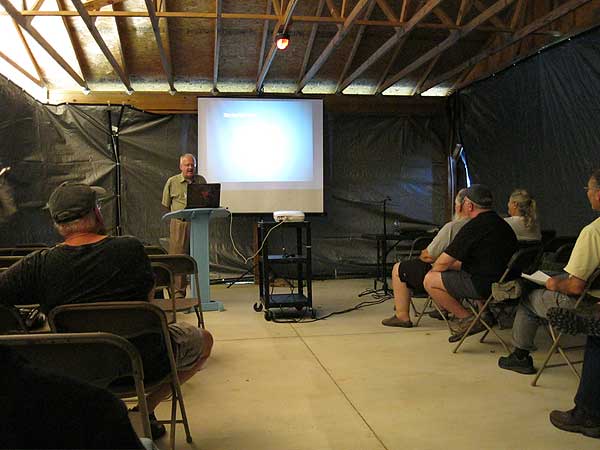
We spent the last day of September at the Peach State Star Gaze.
I gave a talk on planetary imaging, and then we came back rather than staying
to observe. (Too much to do!)
Key point from my talk: Video astronomy works for a different reason than people
originally thought. The original idea was to select the best video frames and
thereby capture moments of exceptionally steady air. But we all use 50% to 100% of the
images from a session — far more than the 2% to 5% that might be considered especially
good. What gives?
The answer is that when you stack a large number of
different randomly blurred images, the result is no longer
a random blur — it is a Gaussian blur, which can be
undone mathematically. And that is what RegiStax and other software packages accomplish.
Permanent link to this entry


|
|
|
This is a private web page,
not hosted or sponsored by the University of Georgia.
Copyright 2011 Michael A. Covington.
Caching by search engines is permitted.
To go to the latest entry every day, bookmark
http://www.covingtoninnovations.com/michael/blog/Default.asp
and if you get the previous month, tell your browser to refresh.
Entries are most often uploaded around 0000 UT on the date given, which is the previous
evening in the United States. When I'm busy, entries are generally shorter and are
uploaded as much as a whole day in advance.
Minor corrections are often uploaded the following day. If you see a minor error,
please look again a day later to see if it has been corrected.
In compliance with U.S. FTC guidelines,
I am glad to point out that unless explicitly
indicated, I do not receive payments, free merchandise, or other remuneration
for reviewing or mentioning products on this web site.
I have a Canon EOS 20Da camera and a Tektronix
TDS 210A oscilloscope on long-term loan from their manufacturers. Other reviewed
products are usually things I purchased for my own use, or occasionally items
lent to me briefly by manufacturers and described as such.
|
|

































